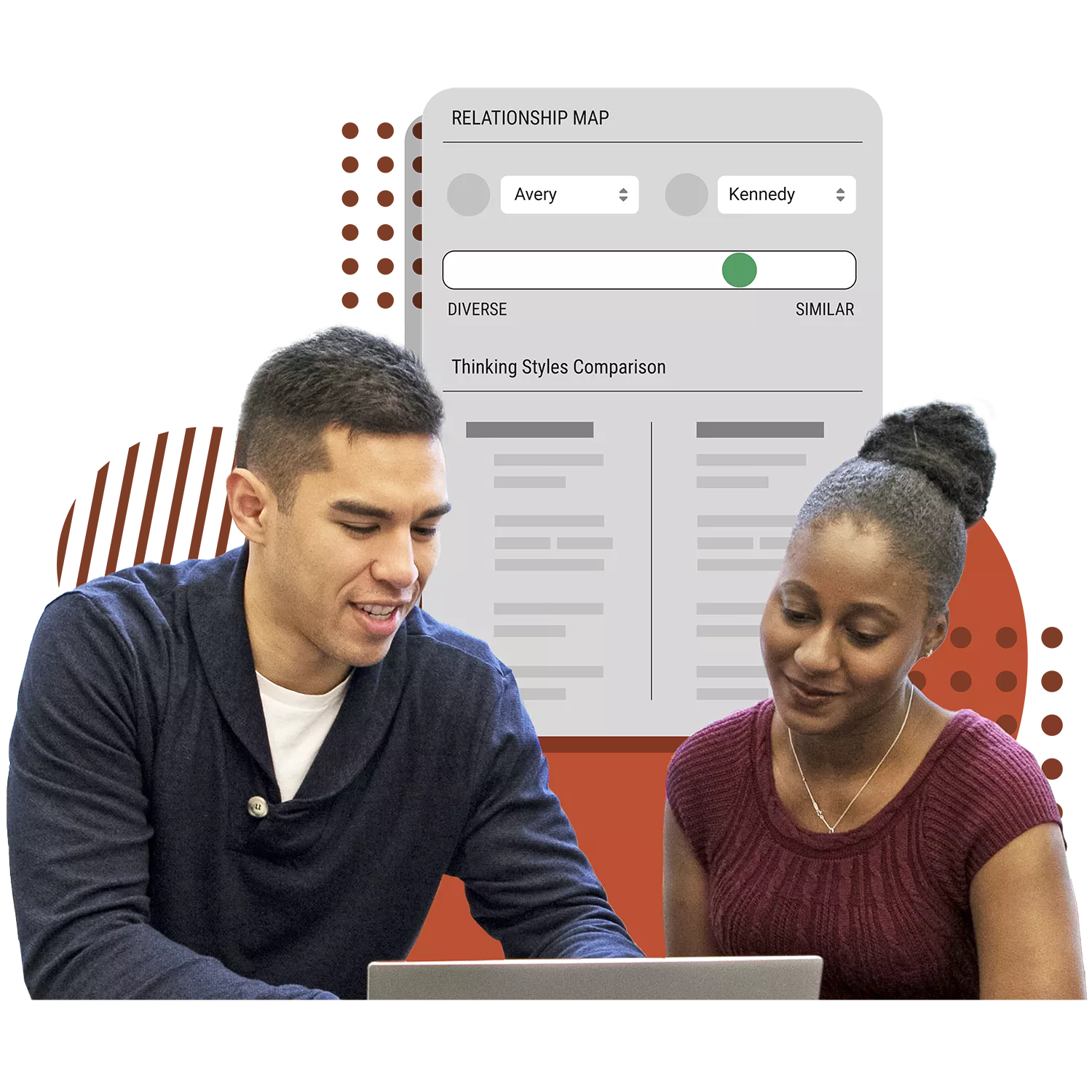Receiving feedback in the workplace is often perceived as walking on eggshells. This process demands high emotional intelligence, communication skills, and an open mind.
Feedback in the workplace is an essential component of professional development and performance management. However, the art of giving and receiving feedback is often misunderstood and can cause tension if not done in the right way.
Here’s where the DISC profile can be highly beneficial. Using DISC when giving or receiving feedback could transform this entire process. Understanding the nuances of DISC can help leaders turn the process from a source of dread into a powerful catalyst for personal and professional growth.
Key Takeaways:
- Understanding an individual’s DISC type can transform the feedback process from a stressful task into a catalyst for growth.
- Feedback strategies can be personalized based on the DISC type of each team member.
- Using DISC profiles in feedback enhances communication, builds empathy, strengthens team unity, and promotes professional growth.
- Leaders are pivotal in integrating DISC profiles into their team’s feedback culture.

DISC Can Simplify Feedback With Behavioral Insights
The DISC profile is a behavioral assessment tool that helps individuals identify their blind spots in communication. It categorizes individuals into four types:
- Dominance (D)
- Influence (I)
- Steadiness (S)
- Conscientiousness (C)
Each type responds differently to feedback, making it a key point in giving effective feedback.
Understanding DISC is one thing, but applying it in a team setting is another ball game. As Learning and Development Leaders, it’s crucial that you not only understand the DISC profile yourself but also effectively train your team members in it.
Start with a clear, simple introduction to DISC and its benefits. Make sure to articulate how understanding one’s DISC profile can help individual teammates enhance their communication skills and excel in their roles. Emphasize the relevance of DISC to real-life situations within your team’s specific workplace context.
To help you get started, visit our post: A Leaders Guide To Using DISC In The Workplace!
Once your team is familiar with the basic concept of DISC, move on to conducting DISC assessments. This process should be framed as a positive opportunity for self-awareness and professional development rather than a test or evaluation.
Take our free DISC assessment to gain actionable insights concerning your results and start receiving Automated Coaching™ to help your team perform more effectively.
Properly introducing DISC to your team and guiding them in its application can lead to more effective feedback sessions and foster an environment conducive to growth and learning. The art of giving and receiving feedback becomes a collaborative effort, raising the level of communication and understanding within the team.

Free Playbook For Creating An Engaging Employee Experience even During Challenging Times
- What The Future Workplace Looks Like
- How To Activate Emotional Intelligence Within Your Team
- Factors Of Employee Motivation
- Strategies For Employee Engagement
- A Hybrid Work Model For Collaboration, Flexibility, & Fulfillment
- The Power Of Coaching In The Workplace
- How To Reduce The Impact Of Labour Turnover

How DISC Can Transform Your Teams Feedback Processes
The DISC profile is not just a personality test; it’s a critical tool for enhancing communication skills and improving the feedback process. By tailoring your feedback to an individual’s DISC type, you align your communication style with their preferences, leading to more useful feedback and performance improvement.
For example, consider a scenario where a manager gives lengthy, detail-oriented feedback to an ‘I’ type employee, unaware of DISC principles. This type of feedback, incompatible with their enthusiastic and big-picture communication style, may make the feedback session unproductive, a pitfall that could be avoided using DISC profile insights.
The Pivotal Role of Leadership in Shaping a DISC-Enhanced Feedback Culture
Within this context, the role of people development becomes critical. Leaders need to understand and apply DISC principles and cultivate a feedback culture within their teams where DISC becomes integral.
4 Ways To Use DISC To Support A Feeback Culture
1. Strategize Feedback Sessions with Mixed-DISC-Type Teams
This involves leaders becoming adept at identifying the DISC profile of each person and tailoring their feedback accordingly. For example, if a leader is providing feedback to an individual who falls under the ‘D’ category (Dominance), they may opt for a more direct, concise approach focusing on solutions rather than dwelling on problems.
In contrast, when dealing with an ‘S’ type (Steadiness), the leader might need to be more patient and supportive, providing feedback with more warmth. This approach makes feedback a personalized tool that resonates more effectively with each person, promoting meaningful performance conversations.
2. Navigate Conflict Resolution Using DISC
Leaders can leverage DISC insights to navigate and mediate conflicts among teammates more effectively. For example, if a conflict arises between a ‘D’ type (who tends to be competitive and assertive) and an ‘I’ type (who prefers a more collaborative and harmonious environment), the leader can use their understanding of these profiles to guide the conversation.
They can respect the ‘D’ type’s need for directness and results while emphasizing the ‘I’ type’s importance of positivity and cooperation. By doing so, leaders can ensure that conflicts become opportunities for learning and growth rather than sources of division.
3. Promote DISC Understanding for Professional Development
Encouraging your team to understand their DISC profiles is integral to fostering a healthy feedback culture. By hosting DISC workshops or sharing resources for self-study, leaders can ensure that everyone understands their communication styles and how they interact with others.
This understanding not only fosters empathy and strengthens team cohesion but also aids in personal development in the workplace by highlighting areas for improvement.
For example, an ‘I’ type individual might realize they need to focus more on details, or a ‘C’ type might work on becoming more open to change. As each person strives for improvement, the team as a whole becomes stronger and more efficient.
This transition requires an open mind and a commitment to using DISC regularly, but the rewards for team performance and cohesion are well worth the effort.
4. Leverage Cloverleaf’s Side-By-Side Thinking Comparison Tool
Utilizing the power of Cloverleaf’s Thinking Comparison tool gives teammates unique insight into their colleagues’ diverse thinking styles and motivational drivers, all through the lens of DISC profiles.

Practical Tips and Strategies for Each DISC Type
Explore our comprehensive guide filled with nuanced strategies for each DISC profile. Each section, illustrated with practical scenarios, provides valuable insight on how to optimize feedback delivery and reception to foster growth and efficient communication.
D Types: The Power of Directness and Efficiency
D types value directness, efficiency, and tangible results, which can feel challenging when giving feedback. However, understanding their communication style and preferences can transform this process into a productive, stress-free experience.
Below are several ways leaders can adapt their approach to communicate with D types effectively:
- Adopt a Direct Approach: D types appreciate straight talk. Discuss the current situation, desired outcomes, and actionable steps to achieve these goals. For instance, if you’re giving feedback to a ‘D’ type salesperson falling behind their quota, emphasize the key points succinctly and directly.
Emphasize Results: D types are results-oriented. When discussing their performance, focus on concrete data and facts rather than emotions or personal opinions. This helps them understand their standing and motivates them to improve.
Promote Independence: Give D types as much independence as possible to achieve their desired outcomes. Respect their abilities and encourage them to devise an action plan, harnessing their pioneering spirit.
Maintain Clarity: D types appreciate clearly defined boundaries, time limits, and resources. Clarity helps them operate efficiently and productively.
Prepare for Energy: It’s common for D types to respond with high energy. Don’t be overwhelmed. Stay strong, clear, and calm, offering respectful feedback that empowers them towards improvement.
I Types: Engaging with Enthusiasm and Creativity
Individuals with an ‘I’ profile are known for their enthusiasm, creativity, and sociability. They thrive when feedback is positive and engaging. Understanding how to navigate their preferences can lead to highly productive interactions. Let’s dive into strategies that make feedback more effective for I types:
- Express Positivity: I types appreciate an optimistic approach. When discussing performance issues, highlight the benefits of the desired outcomes and demonstrate confidence in their abilities to meet these goals. For instance, if an ‘I’ type graphic designer’s creations don’t align with the company’s brand image, offer constructive feedback with an emphasis on positivity.
Focus on the Big Picture: I types are big-picture thinkers who appreciate understanding the broader impact of their work. Make sure to connect individual tasks and performance outcomes to the larger team or organizational goals.
Encourage Creativity: Acknowledge their creative abilities and interpersonal skills. I types tend to be innovative and social, so recognizing these traits can help in fostering a positive feedback environment.
Maintain Engagement: Keep the conversation lively and engaging, as I types prefer interactive discussions. However, be prepared to steer the conversation back on track if they start to wander off-topic.
Ensure a Positive Tone: I types respond better to a firm, measured, and positive tone. They’re likely to be more receptive to your feedback if you can deliver it in an upbeat manner.
Set a Clear Timeline: To ensure understanding and accountability, close by agreeing on a timeline for implementing the suggested improvements. This will help ‘I’ types focus their energy and creativity on meeting their performance goals.
S TYPES: Emphasizing Support and Collaboration
- Embrace Patience and Reassurance: S types thrive in situations where they feel reassured and supported. While discussing areas of improvement, do so patiently, ensuring they understand you are critiquing the performance, not the person.
Highlight Their Strengths and Progress: Along with pointing out areas for improvement, acknowledge their strengths and progress, no matter how small. This balanced approach encourages S types and reinforces their sense of value.
Clarity on Expectations: Be clear about your expectations from S types. Ambiguity can create stress for them, so maintain clear, direct communication about goals and performance standards.
Create a Step-by-Step Plan: Guidance can greatly aid S types. Construct a step-by-step improvement plan together, providing them with a clear path to enhancing their performance.
Regular Check-Ins: Conducting regular feedback sessions helps S types feel secure and valued. Regular check-ins demonstrate your commitment to their development and allow for timely recognition of gradual improvements in their performance.
C TYPES: Precision, Accuracy, and Logical Thinking
Engaging in feedback sessions with C types, known for their conscientiousness, logical thinking, and accuracy, can be greatly enhanced by understanding their preferences. Below are some key strategies that will make your feedback sessions with C types more effective and productive:
- Precision is Key: C types value precise, specific feedback. If you’re discussing a ‘C’ type accountant’s errors in financial reports, make sure your feedback pinpoints the exact mistakes, elucidates their impact, and provides clear guidelines for correction.
Emphasize Facts and Details: Stick to a factual discussion focusing on the current results and the necessary improvements. Provide evidence or examples when necessary, as C types appreciate the meticulous analysis of situations.
Allow Time for Planning: After providing your feedback, give them time to process the information and develop a plan for achieving the desired outcomes. They prefer to take time to think things through.
Establish Clear Deadlines: Agree on a specific time frame for performance improvement, including a final deadline and milestones for reviewing progress. Firm deadlines give them a clear goal to work towards and ensure accountability.
Recognize their Competence: Whether in private or through email, recognize their hard work, precision, or competence. Positive reinforcement goes a long way in motivating C types to continuously improve.

Mastering the Art of Receiving Feedback Using DISC
Receiving feedback constructively requires self-awareness of your own DISC type. Understanding your communication preferences can help you interpret feedback from a new perspective and take action accordingly. This understanding fosters an environment of regular and real-time feedback, aiding in personal development.

Conclusion
Understanding and applying DISC profiles in the workplace can revolutionize the feedback process, transforming it from a potential point of conflict to a tool for growth and improvement. Remember to share feedback regularly and always maintain the right way of communication according to the DISC type.
Leveraging platforms like Cloverleaf can help you foster better understanding and synergy in your team’s interactions, accelerating conflict resolution and fostering a stronger, more cohesive unit.
Visibility into the communication styles, work approaches, and intentions of colleagues can significantly bolster team cohesion, and improve collaboration, impacting organizational effectiveness.
Schedule a meeting today to learn how Cloverleaf can help you develop the leaders who manage teams.




